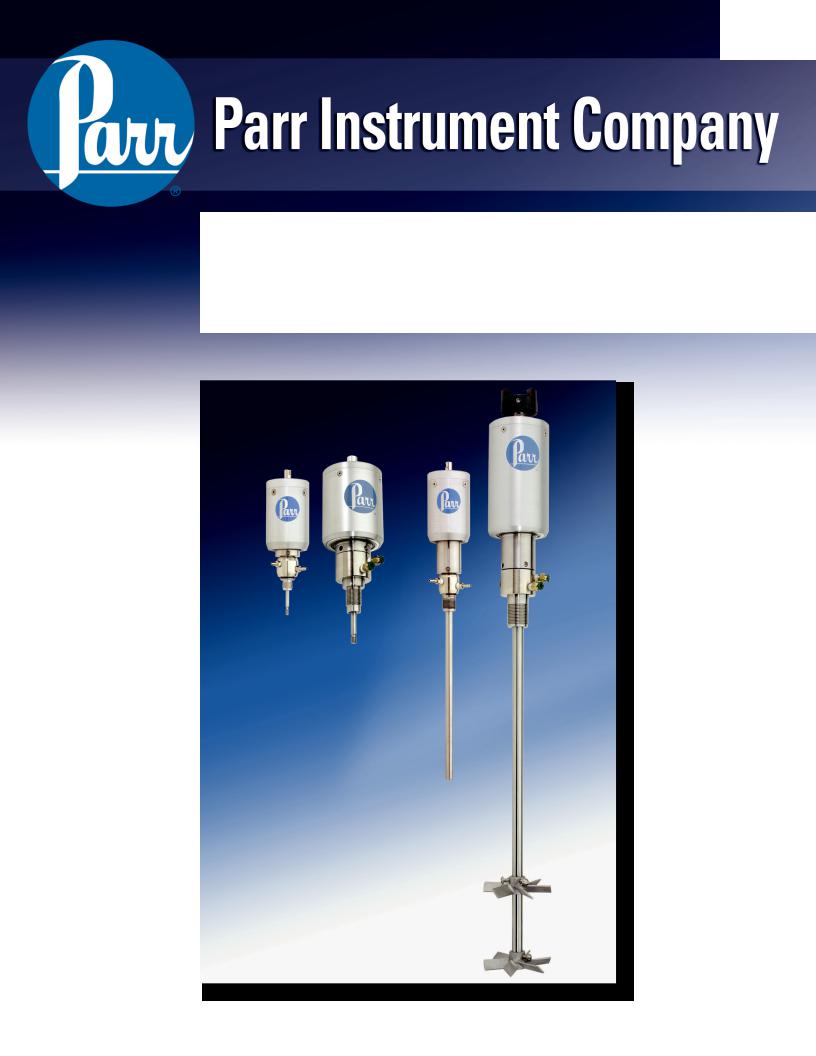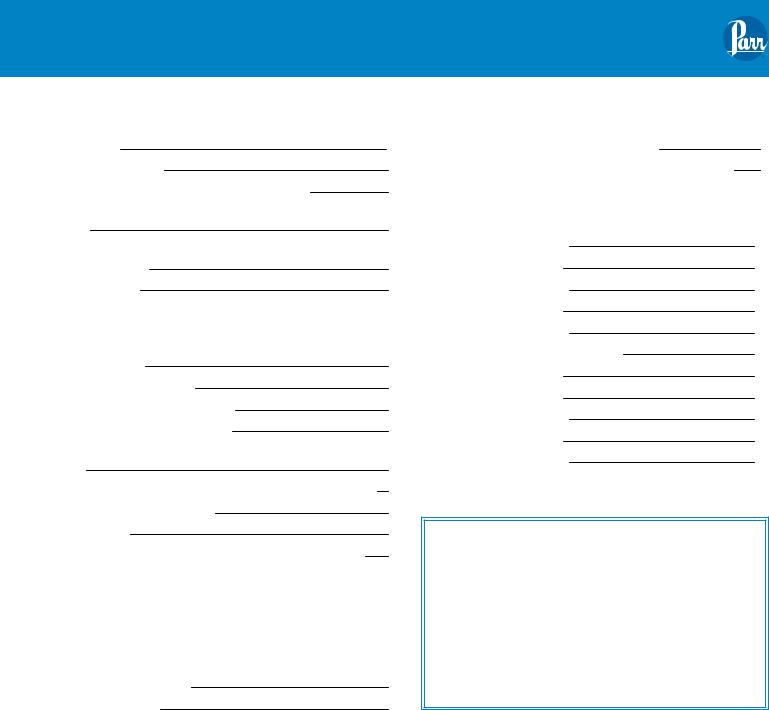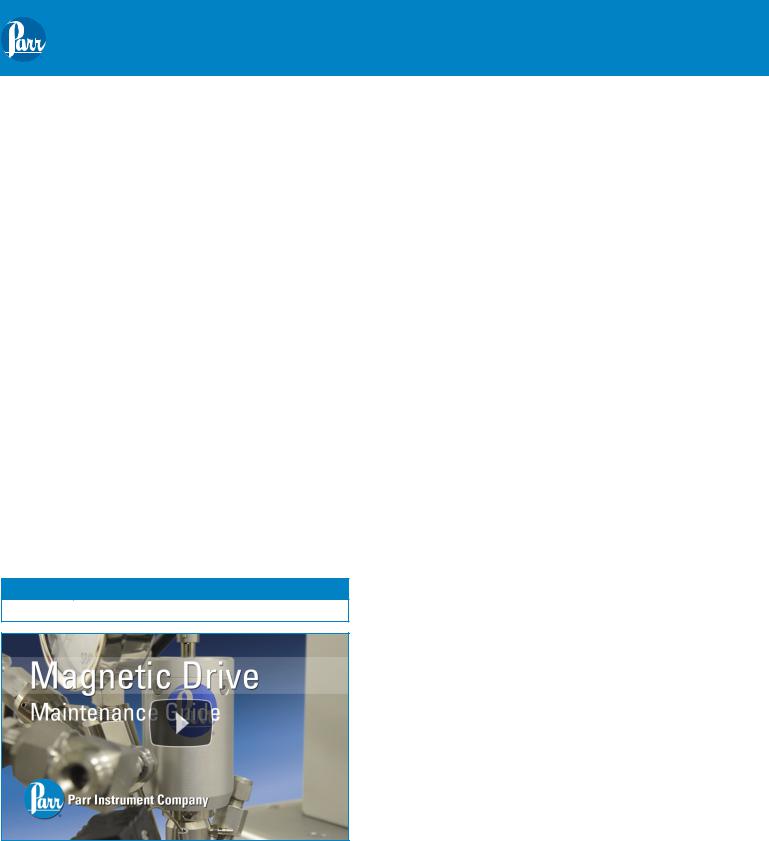Parr Instrument Magnetic Drive User Manual

234M
Parr Magnetic Drives
Operating Instruction Manual

Parr Magnetic Drives
Preface |
3 |
|
|
Description |
3 |
Related Instructions |
3 |
Light Duty A1120HC/A2140HC/A2150HC Series |
3 |
Heavy Duty Drives A1180HC/A1750HC/A2160HC/A2170HC |
|
Series |
3 |
Extra Heavy Duty Drives A1180HC2/A1750HC2/ A2160HC2/ |
|
A2170HC2 Series |
3 |
Characteristics |
3 |
Servicing the Magnetic Drive |
4 |
|
|
The O-Ring Seal |
5 |
Servicing the Outer Drive |
5 |
Disassemble the Outer Drive |
5 |
Reassemble the Outer Drive |
5 |
Removing and Installing Magnetic Drives with Flat Gasket |
|
Seals |
6 |
Removing and Installing Magnetic Drives with Olive Seals |
6 |
Servicing the Cooling Sleeve |
6 |
Older Models |
6 |
Installing the Stirrer Shaft on a Footless Magnetic Drive |
6 |
|
|
Gasket Material Designations |
7 |
|
|
|
|
Accessories |
7 |
|
|
Drive Maintenance Tools |
7 |
Spanner Wrenches |
7 |
Specifications |
8 |
|
|
Magnetic Drives With Lower Foot Bearing |
8 |
Magnetic Drives Without Lower Foot Bearing (Footless) |
9 |
|
|
Drawings and Parts Lists |
10 |
|
|
A1120HC6 Magnetic Drive |
10 |
A1180HC Magnetic Drive |
11 |
A1180HC5 Magnetic Drive |
11 |
A1750HC Magnetic Drive |
12 |
A1750HC2 Magnetic Drive |
12 |
A2140HC/A2140HC2 Magnetic Drive |
13 |
A2150HC Magnetic Drive |
13 |
A2160HC Magnetic Drive |
14 |
A2160HC4 Magnetic Drive |
14 |
A2170HC Magnetic Drive |
15 |
A2170HC2 Magnetic Drive |
15 |
Customer Service
Questions concerning the installation or operation of this instrument can be answered by the Parr Customer Service Department:
1-309-762-7716 • 1-800-872-7720
Fax: 1-309-762-9453 E-mail: parr@parrinst.com http://www.parrinst.com
2 |
P a r r I n s t r u m e n t C o m p a n y |

Preface
Description
The principle operation of Parr magnetic drives provides for attaching the stirrer shaft to an inner set of magnets.This inner assembly is then surrounded by the drive housing that seals to the reactor head allowing pressurization without leakage. A second set of magnets is then mounted around the sealed housing. The outer magnetic assembly is then coupled to a motor drive system to provide rotation.The coupling force between the two sets of magnets permits the shaft to turn at the rpm selected for the motor.
Parr magnetic drives are available in three torque ratings: 16 in-lb, 60 in-lb, and 120 in-lb (1.8 Nm, 6.6 Nm, and 13.2 Nm).The drives are also available with two types of shafts; one that requires a lower support bushing and one that is “footless.”The Model number assigned to each drive depends upon the above selection as well as the type of connection used to mount the drive into the reactor head and the type of upper cap used for connection to the overarm and motor drive system.
Related Instructions
The following Parr publications are available to further your understanding of this equipment and its component parts:
No. Description
201M Limited Warranty
Parr Magnetic Drive Service Instructional Video
Go to http://youtu.be/zjBw5l_yBHw to view a video supplement to aid users with performing routine maintenance on Parr Instrument Company’s Magnetic Drives.
Light Duty A1120HC/A2140HC/A2150HC Series
This is the smallest of the three drives. It is a 4-pole model with 16 inch-pounds coupling torque.This is
Parr Magnetic Drives
normally adequate to carry the usual stirring loads de veloped in a Parr “Mini” reactor and the one and two liter bench top and floor stand models with general purpose stirrers.The outer magnetic drive housing measures 2¼” O. D. x 3½” high.
Heavy Duty Drives A1180HC/A1750HC/ A2160HC/A2170HC Series
This is a 6-pole model with 60 inch pounds of coupling torque to handle most of the stirring loads arising in Parr one and two liter, and one, two, and 5 gallon floor stand reactors with heavy duty stirrers.The drive housing measures 3½” O. D. x 4½ high.
Extra Heavy Duty Drives A1180HC2/ A1750HC2/ A2160HC2/A2170HC2 Series
This is the largest of the three Parr drives. It consists of two, 6-pole magnets assemblies mounted end-to end to provide 120 inch-pounds of coupling torque for use as an alternative drive for large Parr reactors when a strong drive is required to handle very high viscosity loads.The drive housing measures 3½” O.D. x 6½” high.
Conversion from a smaller to a larger drive or to a “footless” drive may require modification to the standard over/arm and motor configuration. It may require a different head.
Note: Unless otherwise indicated, the instructions given here apply to all of the above units.
Characteristics
Parr magnetic drives require minimal attention or maintenance.The specially designed neodymiumironboron permanent magnets used in these drives have excellent temperature stability and can be relied upon to operate for long periods with little or no flux degradation. When properly installed, the outer rotor should spin freely and the inner (driven) unit should follow without slippage, providing a high torque stirring action.The magnets in both inner and outer rotors are epoxy bonded to their iron cores.
Care must be taken to prevent these components from being heated above 100 °C, which would destroy the bonding of the magnet assemblies.To prevent overheating, each magnetic drive has an attached cooling sleeve through which a steady flow of cold water should be fed during all vessel operations at temperatures above 100 ºC.Tubing connections for flowing water connections are provided on each sleeve, and
a 10 foot length of tubing is furnished to connect to a water source.
w w w . p a r r i n s t . c o m |
3 |

Parr Magnetic Drives
Servicing the Magnetic Drive
All non-wetted rotating parts in Parr magnetic drives are permanently lubricated and do not require servicing during normal operation. During operation, inspect the magnetic drive for unusual noise or leakage. If problems are encountered with these items take corrective action.The magnetic drive has internal bearings and thrust washers which require replacement over time due to physical wear. Excessive lateral or axial play in the stirrer shaft is an indication of worn bearings or thrust washers. Labored rotation or excessive debris inside the reactor cylinder also indicates a need for maintenance. It’s difficult to recommend a timebased preventative maintenance interval for the drive due to the wide spectrum of operating conditions encountered.The experience of the laboratory should be used to guide the need for preventative maintenance.
It is advisable to check the drive from time to time for evidence of leakage into the confined space between the inner and outer rotors.This can be done without removing the drive from the vessel head and does not require complete disassembly. While performing maintenance or rebuilding the drive, the PTFE o-ring
that seals the top plug should always be renewed if the plug is removed.To inspect the drive:
1.Remove the four socket head screws located near the top of the outer housing and remove the top cover from the housing.This will expose the plug which aligns the inner rotor and carries the principle O-ring seal.
2.Unscrew the plug, using a 264AC5 face spanner inserted into the two holes at the top of the plug while holding the rotor firmly with a 264AC3 or 264AC4 pin spanner inserted into one of the holes at the bottom of the assembly above the cooling sleeve. With the plug removed, the sleeve bushing and thrust washer at the top of the rotor will be exposed.
3.Check for any evidence of leakage past the O-ring seal. If vapors from the reactor have produced solid deposits in or around the rotor housing, the deposits will have to be removed to keep them from destroying the slide bushings or jamming the rotor. If cleaning is not required, replace the plug and close the drive.
4.If cleaning is required, the inner rotor can be removed without removing the entire drive from the bomb head.To remove: Remove propeller from shaft. For vessels with a one piece shaft, the shaft can be used to push the rotor out of the stirrer housing. For vessels with a lower coupled shaft assembly, the shaft will need to be disconnected from
4 |
P a r r I n s t r u m e n t C o m p a n y |
Outer Driving
Magnetic
Assembly
Inner Magnetic
Rotor
Non-Rotating
Inner Housing
Holes for
Pin Spanner
Wrench
Cooling
Sleeve
Parr Magnetic Drive
the upper shaft. In the larger magnetic drives, the rotor can be removed by attaching a threaded (5/16
– 24) rod to the top of the inner rotor and pulling up from the top of the housing.
The inner rotor is a laser-welded, sealed unit which should require no maintenance, but it can be damaged by overheating as mentioned earlier. With the rotor removed, it may be advisable to replace the three sleeve bushings which guide the inner rotor.Two of these, plus a spacer, are located deep in the magnetic drive housing. The third sleeve bushing is held in the top plug. Although these bushings can be pulled out with a wire hook or scribe, removal is much easier using a specially designed bushing removal tool (See Page 8). Simply screw the threaded end of the removal tool into the bushing until it is firmly engaged, then pull out the bushing.The spacer between the two bushings should slide out freely. Remove the bottom bushing in the same manner.

When replacing the bushings in the magnetic drive housing, slide the parts into place carefully and be sure to separate the two lower bushings with a spacer. A specially designed bushing insertion tool is available for this operation (See Page 8). Using the insertion tool, slide a bushing onto the end of the tool with the longest shank, then insert the tool with the bushing into the opening in the rotor chamber and push it down until the shoulder on the tool strikes the bottom of the chamber.
This will position the bushing properly.Then drop the spacer into the opening and use the short end of the installation tool to insert the upper sleeve bushing, again pushing the tool downward until it strikes the bottom of the plug. When properly installed, the top of the upper bushing should be flush with the bottom of the rotor chamber.
After cleaning the rotor and the chamber, install the inner rotor as follows:
1.Set the lower thrust washer into position so that it will be available to cushion the rotor if it should accidentally slam into the bottom of the chamber.
2.Lower the rotor into the chamber slowly, but be prepared to resist the strong pull of the outer magnets during this operation. Use the same rod employed when removing the rotor to resist the strong pull during assembly.
3.Replace the upper sleeve bushing and the O-ring in the top plug; insert the upper thrust washer; lubricate the threads with 424HC2 anti-seize lubricant (careful not to get any on the O-ring) and screw the top plug into place.Then replace the top cover and secure it with the four socket head screws.
The O-Ring Seal
The O-ring, which seals the top plug in Parr magnetic drives, is made of PTFE. If solvent attack becomes a problem, the O-ring may have to be replaced with an O-ring made of another material.
Servicing the Outer Drive
The outer drive is supported by two high quality sealed ball bearings which do not require lubrication. Any oil leak or noise from the bearing will indicate that the seal or the bearing has failed and the bearing must be replaced.
Parr Magnetic Drives
Disassemble the Outer Drive
1.Remove the four socket head screws located near the top of the outer housing; then lift the cover from the housing to expose the upper snap ring. Peel the snap ring out of its groove with a small screwdriver; slide it upward and remove it.
2.Take a firm grip on the outer drive housing and pull it upward to separate the outer assembly from the magnetic drive housing.The lower bearing may not come out with the housing. If not, remove at this time.
Reassemble the Outer Drive
1.Slide the lower spiral snap ring back into its groove; then slide the lower ball bearing onto the inner housing.The inner magnets should hold the bearing at the middle of the housing.
2.Slide the outer drive assembly over the rotor, thereby pushing the lower bearing down against the lower spiral snap ring. Hold both parts firmly during this step so that the magnets do not slam the outer drive into place.
3.Insert the upper wave spring into its groove in the outer drive housing and slide the ball bearing into place against the wave spring, then anchor the bearing by pushing the retaining snap ring downward until it snaps into its groove above the bearing. During this step sufficient pressure must be applied against the snap ring and force the wave spring downward and allow the snap ring to drop bearing to force the wave spring downward
and allow the snap ring to drop into its groove.This can be done with a pair of screw drivers, using alternating pressure on the snap ring.This must be done carefully to be sure that the screw drivers do not slip and damage the seals in the bearings.To simplify the operation, Parr offers a magnetic drive assembly tool (Part No. 2086HC) consisting of a properly sized cup which can be pushed downward against the snap ring to force it into its groove. There are cups on the 2086HC assembly tool to fit both the small and larger Parr magnetic drives.
4.Replace the top cover and secure it with the four socket head screws.
w w w . p a r r i n s t . c o m |
5 |
